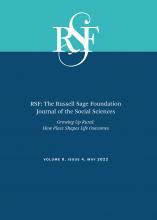Research Article
Open Access
Rural Kids and Wealth
Lisa A. Keister, James W. Moody, Tom Wolff
RSF: The Russell Sage Foundation Journal of the Social Sciences May 2022, 8 (4) 155-182; DOI: https://doi.org/10.7758/RSF.2022.8.4.07
Lisa A. Keister
aProfessor of sociology and public policy at Duke University and an affiliate of the Duke Network Analysis Center and the Duke population Research Initiative
James W. Moody
bProfessor of sociology at Duke University, United States
Tom Wolff
cPhD candidate in the Department of Sociology at Duke University, United States

REFERENCES
- ↵
- Aguilera, Michael Bernabé
- ↵
- Alba, Richard, and
- Victor Nee
- ↵
- Alba, Richard,
- Philip Kasinitz, and
- Mary C. Waters
- ↵
- Bearman, Peter S., and
- James Moody
- ↵
- Biddle, Catharine, and
- Ian Mette
- ↵
- Boen, Courtney
- ↵
- Boen, Courtney, and
- Yang C. Yang
- ↵
- Bricker, Jesse,
- Lisa J. Dettling,
- Alice Henriques,
- Joanne W. Hsu,
- Lindsay Jacobs,
- Kevin B. Moore,
- Sarah Pack,
- John Sabelhaus,
- Jeffrey Thompson, and
- Richard A. Windle
- ↵
- Bricker, Jesse,
- Lisa J. Dettling,
- Alice Henriques,
- Joanne W. Hsu,
- Kevin B. Moore,
- John Sabelhaus,
- Jeffrey Thompson, and
- Richard A. Windle
- ↵
- Carlson, Edward, and
- Justin Goss
- ↵
- Carr, Patrick J., and
- Maria J. Kefalas
- ↵
- Carson, Jessica A., and
- Marybeth J. Mattingly
- ↵
- Chang, Mariko Lin
- ↵
- ↵
- ↵
- Chiteji, Ngina S., and
- Frank P. Stafford
- ↵
- Cobb, Robert A.,
- Walter G. McIntire, and
- Phillip A. Pratt
- ↵
- Coleman, James S
- ↵
- ↵
- Crockett, Lisa J.,
- Michael J. Shanahan, and
- Julia Jackson-Newsom
- ↵
- Crosnoe, Robert
- ↵
- ↵
- Duncan, Cynthia M
- ↵
- Economic Research Service
- ↵
- Economic Research Service
- ↵
- Ennett, Susan T., and
- Karl E. Bauman
- ↵
- ↵
- Fligstein, Neil, and
- Adam Goldstein
- ↵
- Fry, Richard
- ↵
- Gibbs, Robert M., and
- John B. Cromartie
- ↵
- Gibson-Davis, Christina,
- Lisa A. Keister, and
- Lisa Gennetian
- ↵
- Glasgow, Nina
- ↵
- Goodman, Laurie,
- Jun Zhu,
- Amanda Gold, and
- Rolf Pendall
- ↵
- Haller, William,
- Alejandro Portes, and
- Scott M. Lynch
- ↵
- ↵
- Hamilton, Brady E.,
- Lauren M. Rossen, and
- Amy M. Branum
- ↵
- Hamilton, Lawrence C.,
- Leslie R. Hamilton,
- Cynthia M. Duncan, and
- Chris R. Colocousis
- ↵
- Haynie, Dana L
- ↵
- Heaton, Tim B.,
- Daniel T. Lichter, and
- Amoateng Amoateng
- ↵
- Howarth, William
- ↵
- Johnson, Kenneth M
- ↵
- Jones, Larry E., and
- Michele Tertilt
- ↵
- Keister, Lisa A
- ↵
- Keister, Lisa A
- ↵
- Keister, Lisa A
- ↵
- ↵
- ↵
- Keister, Lisa A
- ↵
- Keister, Lisa A.,
- Jody Agius Vallejo, and
- E. Paige Borelli
- ↵
- ↵
- Killewald, Alexandra,
- Fabian T. Pfeffer, and
- Jared N. Schachner
- ↵
- Kreager, Derek A
- ↵
- ↵
- ↵
- Lichter, Daniel T., and
- Deborah Graefe
- ↵
- Lichter, Daniel T.,
- Vincent Roscigno, and
- Dennis J. Condron
- ↵
- Lichter, Daniel T., and
- Kai A. Schafft
- ↵
- ↵
- MacTavis, Katherine, and
- Sonya Salamon
- ↵
- McLaughlin, Diane. K,
- Daniel T. Lichter, and
- Gail M. Johnston
- ↵
- ↵
- Mercken, Liesbeth,
- Tom J. Snijders,
- Christian Steglich,
- Erkki Vartiainen, and
- Hein de Vries
- ↵
- Milner, Murray
- ↵
- ↵
- Ng, Alison Stewart, and
- Kelleen Kaye
- ↵
- ↵
- ↵
- Portes, Alejandro, and
- Min Zhou
- ↵
- Probst, Janice C.,
- Jessica D. Bellinger,
- Katrina M. Walsemann,
- James Hardin, and
- Saundra H. Glover
- ↵
- Sherman, Jennifer, and
- Rayna Sage
- ↵
- Shi, Ying, and
- James W. Moody
- ↵
- Singh, Kusum, and
- Sandra Dika
- ↵
- ↵
- Smith, Kristin
- ↵
- ↵
- Stegner, Wallace
- ↵
- Taylor, Paul,
- Rakeesh Kochhar,
- Richard Fry,
- Gabriel Velasco, and
- Seth Motel
- ↵
- Thiede, Brian C.,
- Hyojung Kim, and
- Tim Slack
- ↵
- ↵
- Tsvetkova, Alexandra,
- Mark Partridge, and
- Michael Betz
- ↵
- ↵
- Vallejo, Jody Agius, and
- Lisa A. Keister
- ↵
- von Reichert, Christiane,
- John B. Cromartie, and
- Ryan O. Arthun
- ↵
- Zhou, Min,
- Jennifer Lee,
- Jody Agius Vallejo,
- Rosaura Tafoya-Estrada, and
- Yang Sao Xiong
In this issue
Rural Kids and Wealth
Lisa A. Keister, James W. Moody, Tom Wolff
RSF: The Russell Sage Foundation Journal of the Social Sciences May 2022, 8 (4) 155-182; DOI: 10.7758/RSF.2022.8.4.07
Jump to section
Related Articles
- No related articles found.
Cited By...
- No citing articles found.





